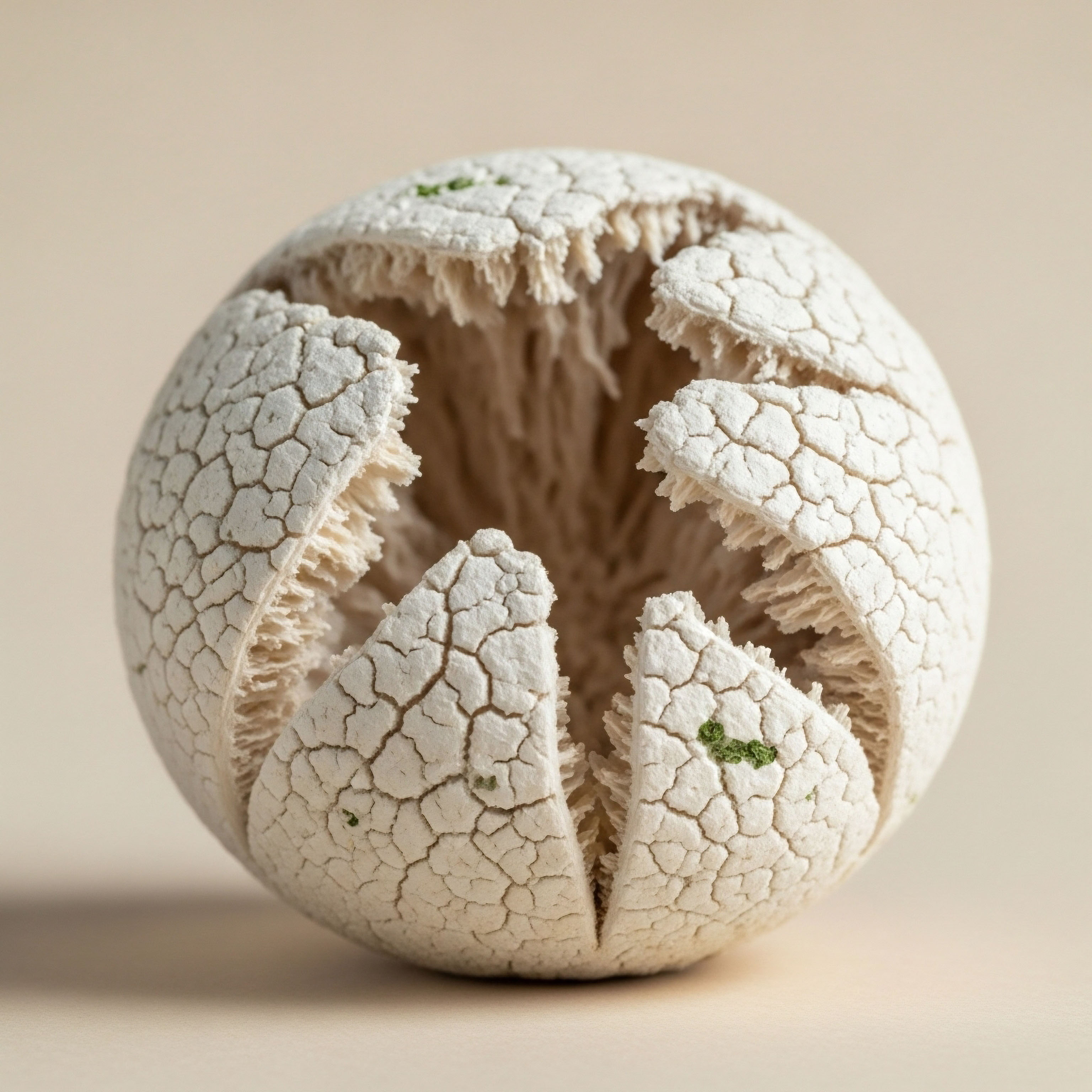

Fundamentals
Many individuals experience a subtle yet persistent shift in their vitality, a gradual decline in the ease with which their bodies once repaired themselves or maintained optimal function. Perhaps you have noticed a slower recovery from physical exertion, a diminished capacity for deep, restorative sleep, or a general sense that your internal systems are not operating with their previous efficiency.
These sensations are not merely signs of aging; they often reflect changes within the intricate communication networks of your biological systems, particularly those governing cellular regeneration and metabolic balance. Understanding these underlying mechanisms offers a pathway to reclaiming that lost vigor.
The human body possesses an inherent capacity for self-renewal, a remarkable ability to repair damaged tissues and replace aging cells. This continuous process, known as cellular regeneration, is fundamental to maintaining health and function throughout life. It involves a complex interplay of signaling molecules, growth factors, and specialized cells that work in concert to rebuild and restore.
When this delicate balance is disrupted, the effects can manifest as the very symptoms many people experience, prompting a search for ways to support the body’s intrinsic restorative powers.
Cellular regeneration, the body’s innate repair system, is vital for sustained health and function.
At the heart of this regenerative capacity lies a sophisticated internal messaging service, where various chemical messengers transmit instructions between cells and tissues. Among these messengers, peptides play a particularly significant role. Peptides are short chains of amino acids, the building blocks of proteins, and they act as highly specific signaling molecules.
Unlike larger proteins, their smaller size allows them to interact precisely with cellular receptors, initiating cascades of biochemical events that influence a wide array of physiological processes, including those related to tissue repair and growth.
Consider the body’s endocrine system, a master orchestrator of these internal communications. Hormones, which are often peptides or derived from them, regulate nearly every bodily function, from metabolism and mood to growth and reproduction. When hormonal equilibrium is disturbed, the ripple effects can be widespread, impacting cellular health and regenerative capabilities. For instance, a decline in certain growth-promoting hormones can directly impede the body’s ability to mend and renew itself, leading to slower wound healing or reduced muscle recovery.

What Are Peptides and How Do They Function?
Peptides are naturally occurring biological molecules that perform specific functions within the body. They are distinct from proteins in their shorter chain length, typically comprising 2 to 50 amino acids. This structural characteristic allows peptides to be readily absorbed and to interact with cellular receptors with remarkable specificity. Their actions are diverse, ranging from modulating immune responses and regulating inflammation to influencing cellular proliferation and differentiation.
The mechanisms by which peptides exert their effects are varied. Some peptides mimic the actions of naturally occurring hormones, binding to the same receptors and triggering similar biological responses. Others might inhibit specific enzymes or block receptor activity, thereby preventing undesirable cellular processes.
A key aspect of peptide function involves their ability to activate or inhibit signaling pathways within cells, which can regulate processes such as tissue repair and immune responses. They can also influence gene expression, promoting the creation of beneficial proteins or suppressing harmful ones.
The specificity of peptides means they can target particular cellular processes with minimal off-target effects, a distinct advantage over many conventional pharmaceutical agents. This precision makes them compelling candidates for therapeutic interventions aimed at restoring cellular function and promoting regeneration.

The Body’s Regenerative Blueprint
The body’s capacity for regeneration is not a singular event but a continuous cycle of cellular turnover and repair. Specialized cells, such as stem cells, serve as a reservoir for this renewal, possessing the ability to differentiate into various cell types needed for tissue maintenance and repair.
When tissues are damaged, these stem cells are activated, proliferating and differentiating to replace lost or injured cells. This intricate dance of cellular activity is orchestrated by a symphony of signaling molecules, many of which are peptides.
For example, in muscle tissue, satellite cells, a type of stem cell, are crucial for muscle regeneration and growth. Testosterone, a steroid hormone, influences the activation, proliferation, differentiation, and fusion of these satellite cells with existing muscle fibers, contributing to muscle repair and hypertrophy. This highlights how hormonal balance directly impacts the body’s regenerative capacity at a cellular level.
The health of our tissues, from skin to internal organs, relies on this ongoing cellular renewal. When this process slows or becomes inefficient, it can contribute to the symptoms associated with aging or chronic conditions. Supporting these intrinsic regenerative pathways, often through targeted interventions like peptide therapies, represents a proactive approach to maintaining long-term vitality.


Intermediate
As we consider the body’s intricate systems, it becomes clear that optimizing cellular regeneration requires a targeted approach, often involving specific peptide therapies that interact with the endocrine system. These protocols aim to recalibrate internal signaling, supporting the body’s inherent ability to heal and restore. The selection of a particular peptide or hormonal intervention depends on the specific physiological goals, whether it is enhancing muscle recovery, improving metabolic health, or supporting tissue repair.

Growth Hormone Peptide Therapies
Growth hormone (GH) plays a central role in cellular repair, muscle maintenance, and metabolic regulation. As individuals age, natural GH levels often decline, contributing to slower recovery and changes in body composition. Growth hormone-releasing peptides (GHRPs) and growth hormone-releasing hormone (GHRH) analogs are designed to stimulate the body’s own GH production, offering a more physiological approach than direct GH administration.
Growth hormone-releasing peptides stimulate the body’s natural growth hormone production, aiding cellular repair and metabolic balance.
Several key peptides are utilized in this context, each with distinct mechanisms of action:
- Sermorelin ∞ This synthetic peptide mimics the active segment of naturally occurring GHRH, binding to specific receptors on the anterior pituitary gland. This binding stimulates the synthesis and release of endogenous GH in a pulsatile manner, similar to the body’s natural rhythm. Sermorelin’s influence on GH levels can support protein synthesis, enhance fat metabolism, and improve cell regeneration and tissue growth. It is often considered for its potential in research involving cellular repair and metabolic processes.
- Ipamorelin and CJC-1295 ∞ This combination represents a synergistic approach to GH release. Ipamorelin acts as a selective GH secretagogue, binding to specific receptors in the hypothalamus and pituitary, thereby increasing the natural release of GH by mimicking ghrelin’s effects. CJC-1295, a GHRH analog, extends the half-life of GHRH, providing a sustained stimulation of GH production from the pituitary gland. Together, these peptides can amplify GH release, promoting muscle growth, fat loss, and accelerated recovery from physical stress. Their combined action supports cellular replication, which is essential for healing from injuries.
- Tesamorelin ∞ This synthetic peptide specifically stimulates the secretion of GHRH, leading to increased GH production from the pituitary gland. Tesamorelin has demonstrated effects on lipid metabolism, reducing abdominal fat accumulation, and enhancing insulin sensitivity. It supports tissue repair, collagen synthesis, and overall vitality by boosting GH levels, which helps rebuild and regenerate tissues. Clinical trials have explored its effects on metabolic parameters and nerve regeneration.
- Hexarelin ∞ A synthetic hexapeptide, Hexarelin is a ligand of the ghrelin receptor (GHS-R1a). It has been shown to stimulate cell proliferation and protect against cell death in certain contexts, primarily through the activation of specific intracellular pathways. Hexarelin has also been reported to regulate metabolic processes and exhibit cardioprotective effects independent of GH release.
- MK-677 (Ibutamoren) ∞ This is a non-peptide, orally active growth hormone secretagogue that mimics ghrelin, binding to the GHS-R1a receptor. MK-677 increases the natural secretion of GH and insulin-like growth factor 1 (IGF-1) without significantly affecting cortisol levels. It supports muscle protein synthesis, improves fat metabolism, and enhances tissue repair. Research indicates its potential benefits for appetite, body composition, muscle strength, and sleep quality, which is crucial for natural GH secretion.

Other Targeted Peptides for Cellular Support
Beyond growth hormone modulation, other peptides offer specific benefits for cellular regeneration and overall well-being:
- PT-141 (Bremelanotide) ∞ This synthetic peptide acts as a melanocortin receptor agonist, primarily targeting receptors in the brain that regulate sexual arousal and desire. While its main application is in sexual health, the melanocortin system also influences various physiological functions, including appetite regulation. Its central mechanism of action distinguishes it from traditional vascular-acting medications.
- Pentadeca Arginate (PDA) ∞ This synthetic peptide is closely related to Body Protection Compound 157 (BPC-157), a naturally occurring peptide found in human gastric juice. PDA is designed to promote tissue regeneration and recovery, with an arginate salt for enhanced stability. It is believed to work through several pathways, including promoting angiogenesis (the formation of new blood vessels), reducing inflammation, and enhancing collagen synthesis. PDA has shown promise in accelerating the healing of various tissues, including muscles, tendons, and skin, and may aid in decreasing discomfort in damaged areas.

Hormonal Optimization Protocols and Cellular Health
Hormonal balance is foundational to cellular health and regenerative processes. Targeted hormone replacement therapy (HRT) protocols, for both men and women, aim to restore physiological levels of key hormones, thereby supporting systemic well-being and cellular function.

Testosterone Replacement Therapy for Men
For men experiencing symptoms of low testosterone, or hypogonadism, testosterone replacement therapy (TRT) can significantly impact cellular health. Testosterone, the primary male sex hormone, plays a vital role in muscle mass, bone density, and overall physical performance. TRT can increase circulating endothelial progenitor cells (EPCs), which are bone marrow-derived cells essential for endothelial repair and overall cardiovascular health. This highlights testosterone’s direct influence on cellular repair mechanisms within the vascular system.
Standard TRT protocols often involve weekly intramuscular injections of Testosterone Cypionate. To mitigate potential side effects and maintain natural testicular function, additional medications are frequently included:
- Gonadorelin ∞ Administered via subcutaneous injections, Gonadorelin is a synthetic decapeptide that mimics natural gonadotropin-releasing hormone (GnRH). When given in a pulsatile manner, it stimulates the anterior pituitary gland to release luteinizing hormone (LH) and follicle-stimulating hormone (FSH). LH stimulates Leydig cells in the testes to produce testosterone, while FSH supports spermatogenesis. This helps maintain natural testosterone production and fertility, particularly important for men on TRT.
- Anastrozole ∞ This oral tablet is a nonsteroidal aromatase inhibitor that blocks the conversion of testosterone to estrogen. By reducing estrogen levels, Anastrozole helps mitigate estrogen-related side effects such as gynecomastia or water retention, which can occur with increased testosterone levels.
- Enclomiphene ∞ This medication, a selective estrogen receptor modulator (SERM), may be included to support LH and FSH levels, particularly in men seeking to preserve fertility while optimizing testosterone.
The goal of male hormonal optimization extends beyond symptom relief; it aims to restore a biochemical environment conducive to robust cellular function and overall physiological resilience.

Testosterone Replacement Therapy for Women
Women also experience symptoms related to declining hormonal levels, particularly during peri-menopause and post-menopause. Testosterone, while considered a primary male hormone, is crucial for female physiology, influencing sexual function, bone density, muscle mass, and cognitive well-being.
Protocols for women typically involve lower doses of Testosterone Cypionate, often administered weekly via subcutaneous injection. The dosage is carefully titrated to achieve physiological levels, avoiding supraphysiological concentrations.
Other considerations in female hormonal balance include:
- Progesterone ∞ This hormone is prescribed based on menopausal status and individual needs, playing a role in menstrual cycle regulation and uterine health.
- Pellet Therapy ∞ Long-acting testosterone pellets offer a convenient administration method, providing sustained release of testosterone.
- Anastrozole ∞ In some cases, Anastrozole may be used when appropriate to manage estrogen levels, particularly if there is a concern about excessive testosterone conversion to estrogen.
The aim of female hormonal optimization is to alleviate symptoms and to support cellular and systemic health, contributing to improved quality of life and long-term well-being.

Post-TRT or Fertility-Stimulating Protocol for Men
For men who have discontinued TRT or are trying to conceive, a specific protocol is often implemented to stimulate natural testosterone production and support fertility. This protocol typically includes a combination of agents designed to reactivate the hypothalamic-pituitary-gonadal (HPG) axis.
The HPG axis is a complex feedback loop involving the hypothalamus, pituitary gland, and gonads, which regulates hormone production. Exogenous testosterone can suppress this axis, leading to reduced natural testosterone production and impaired fertility. The post-TRT protocol aims to reverse this suppression.
Key components of this protocol include:
- Gonadorelin ∞ Administered in a pulsatile manner, Gonadorelin stimulates the pituitary to release LH and FSH, thereby signaling the testes to resume testosterone production and spermatogenesis.
- Tamoxifen ∞ A selective estrogen receptor modulator (SERM), Tamoxifen blocks estrogen’s negative feedback on the hypothalamus and pituitary, leading to increased LH and FSH secretion. This, in turn, stimulates testicular testosterone production and sperm development.
- Clomid (Clomiphene Citrate) ∞ Another SERM, Clomid works similarly to Tamoxifen by blocking estrogen receptors in the hypothalamus and pituitary, promoting increased gonadotropin release. It is widely used to stimulate ovulation in women and to increase testosterone and sperm production in men.
- Anastrozole (optional) ∞ May be included to manage estrogen levels, particularly if there is a concern about excessive estrogen production during the recovery phase.
This comprehensive approach supports the body’s natural hormonal pathways, facilitating a return to endogenous hormone production and reproductive function.
| Peptide | Primary Mechanism of Action | Key Cellular Effects |
|---|---|---|
| Sermorelin | Mimics GHRH, stimulates pituitary GH release | Protein synthesis, fat metabolism, cell regeneration, tissue growth |
| Ipamorelin / CJC-1295 | Ipamorelin mimics ghrelin, CJC-1295 extends GHRH action; both increase GH release | Muscle growth, fat loss, accelerated recovery, cellular replication for healing |
| Tesamorelin | Stimulates GHRH secretion, increases pituitary GH production | Improved lipid metabolism, reduced abdominal fat, enhanced insulin sensitivity, collagen synthesis |
| Hexarelin | Ghrelin receptor agonist (GHS-R1a) | Cell proliferation, protection against cell death, metabolic regulation, cardioprotection |
| MK-677 (Ibutamoren) | Non-peptide ghrelin mimetic, GHS-R1a agonist | Increased GH and IGF-1, muscle protein synthesis, fat metabolism, tissue repair, improved sleep |
| PT-141 | Melanocortin receptor agonist (MC3R, MC4R) | Central nervous system modulation of sexual arousal and desire |
| Pentadeca Arginate (PDA) | Promotes angiogenesis, reduces inflammation, enhances collagen synthesis | Tissue regeneration, wound healing, muscle and tendon repair, skin integrity |


Academic
The profound impact of specific peptide therapies on cellular regeneration can be understood by examining their interactions within the complex regulatory systems of the body. This requires a deep dive into endocrinology, molecular biology, and systems physiology, revealing how these targeted agents influence cellular behavior at a fundamental level. The body operates as an interconnected network, where signals from one system can reverberate throughout others, influencing overall health and regenerative capacity.

The Hypothalamic-Pituitary-Gonadal Axis and Cellular Renewal
The Hypothalamic-Pituitary-Gonadal (HPG) axis serves as a prime example of such interconnectedness, playing a central role in reproductive health and extending its influence to cellular regeneration across various tissues. This axis begins in the hypothalamus, which releases gonadotropin-releasing hormone (GnRH) in a pulsatile fashion.
GnRH then acts on the anterior pituitary gland, stimulating the release of luteinizing hormone (LH) and follicle-stimulating hormone (FSH). These gonadotropins, in turn, act on the gonads (testes in men, ovaries in women) to regulate sex steroid production and gametogenesis.
Disruptions in this axis, whether due to aging, stress, or other factors, can lead to hormonal imbalances that compromise cellular function. For instance, declining testosterone levels in men are associated with reduced muscle mass and strength, and impaired endothelial repair.
The administration of exogenous testosterone, as in TRT, has been shown to increase circulating endothelial progenitor cells (EPCs), which are critical for vascular health and repair. This demonstrates a direct link between gonadal hormone levels and the body’s capacity for cellular repair in the cardiovascular system.
The use of peptides like Gonadorelin, a synthetic GnRH analog, offers a precise way to modulate the HPG axis. When administered in a pulsatile manner, Gonadorelin stimulates the pituitary to release LH and FSH, thereby reactivating endogenous hormone production.
This mechanism is particularly relevant in post-TRT protocols, where the goal is to restore the body’s natural hormonal rhythm and support fertility. The cellular response involves the activation of the phospholipase C pathway, leading to the release of calcium ions and activation of protein kinase C, culminating in LH and FSH secretion.

Growth Hormone Secretagogues and Somatic Cell Dynamics
The influence of growth hormone (GH) on cellular regeneration is mediated primarily through its downstream effector, insulin-like growth factor 1 (IGF-1). GH stimulates the liver to produce IGF-1, which then acts on various tissues to promote protein synthesis, cell proliferation, and tissue growth. The decline in GH and IGF-1 levels with age contributes to a reduction in the body’s regenerative capacity, affecting muscle, bone, and skin health.
Peptides that act as GH secretagogues, such as Sermorelin, Ipamorelin, CJC-1295, Tesamorelin, and MK-677, are designed to restore more youthful GH and IGF-1 profiles.
- Sermorelin, by mimicking GHRH, binds to specific receptors on pituitary somatotrophs, triggering a cascade involving cAMP as a secondary messenger, which culminates in GH transcription and release. This pulsatile release is crucial for maintaining physiological feedback mechanisms and reducing the risk of side effects associated with constantly elevated GH levels.
- The combination of Ipamorelin and CJC-1295 offers a dual mechanism ∞ Ipamorelin selectively binds to the ghrelin receptor (GHS-R1a), increasing the amplitude of GH pulses, while CJC-1295, a GHRH analog, increases the frequency and duration of these pulses. This synergistic action supports cellular replication and collagen synthesis, which are fundamental for tissue repair and muscle growth.
- Tesamorelin, a stabilized GHRH analog, has been shown to stimulate GH secretion physiologically. Its effects extend to improving fat quality by increasing adipose tissue density, suggesting a positive impact on metabolic health beyond mere fat quantity reduction. This indicates a cellular-level reorganization of fat tissue, contributing to improved metabolic function.
- Hexarelin, a ghrelin receptor agonist, demonstrates GH-independent effects on cellular protection and anti-inflammatory pathways. Research indicates its ability to protect cardiomyocytes from cell death and modulate peroxisome proliferator-activated receptor gamma (PPAR-γ) activity in macrophages, which is involved in lipid metabolism and insulin sensitization.
- MK-677 (Ibutamoren), a non-peptide ghrelin mimetic, binds to the GHS-R1a receptor, leading to increased GH and IGF-1 levels. Its influence on deep sleep cycles is particularly relevant, as the majority of natural GH secretion occurs during slow-wave sleep. This indirect mechanism supports cellular recovery and regeneration by optimizing the body’s natural restorative processes.
The cellular actions of these GH secretagogues extend to various tissues, promoting protein synthesis, enhancing fat metabolism, and improving cell regeneration and tissue growth. This systemic influence underscores their potential in anti-aging protocols and for individuals seeking to optimize physical performance and recovery.

Peptides in Tissue Repair and Anti-Inflammatory Pathways
Beyond hormonal regulation, specific peptides directly influence tissue repair and inflammatory responses at the cellular level. These agents often act by modulating signaling pathways involved in wound healing, angiogenesis, and immune cell function.
Pentadeca Arginate (PDA), a synthetic form of BPC-157, exemplifies this direct cellular influence. PDA is believed to promote angiogenesis by stimulating the formation of new blood vessels, a critical step in wound healing and tissue repair. This improved blood flow ensures adequate oxygen and nutrient supply to damaged tissues, accelerating the healing process.
Furthermore, PDA exhibits anti-inflammatory properties, which can alleviate pain and promote faster healing by reducing swelling at the cellular site of injury. It also supports the synthesis of extracellular matrix proteins, such as collagen, which are essential for the structural integrity and repair of tissues like skin, muscles, and tendons. Research suggests PDA can increase the expression of growth hormone receptors in tendon fibroblasts, enhancing their proliferation and migration, which are vital for wound closure and tissue remodeling.
The precise mechanisms of these peptides involve complex cellular interactions. For instance, PDA’s promotion of vascular endothelial cell growth occurs partly through stimulation of the cell surface receptor VEGFR2, which is active in the nitric oxide signaling pathway. This molecular interaction highlights the specificity with which peptides can orchestrate cellular responses.
Another peptide, PT-141 (Bremelanotide), primarily acts on melanocortin receptors (MC3R and MC4R) in the central nervous system. While its most recognized effect is on sexual function, the melanocortin system is involved in a broader range of physiological processes, including inflammation and energy homeostasis. The activation of these receptors by PT-141 leads to a cascade of neuronal activations, demonstrating a neuro-modulatory influence that extends beyond simple physiological responses.
Peptides like Pentadeca Arginate directly influence tissue repair by promoting new blood vessel formation and reducing cellular inflammation.
The ability of these peptides to modulate cellular processes, reduce inflammation, and support tissue regeneration positions them as valuable tools in personalized wellness protocols. Their targeted actions at the cellular and molecular levels offer a sophisticated approach to restoring physiological balance and enhancing the body’s inherent capacity for self-repair.
| Protocol | Primary Hormones/Peptides | Cellular/Systemic Impact |
|---|---|---|
| Male Testosterone Optimization | Testosterone Cypionate, Gonadorelin, Anastrozole, Enclomiphene | Increases circulating endothelial progenitor cells, supports Leydig cell function, modulates estrogen metabolism, stimulates spermatogenesis |
| Female Testosterone Balance | Testosterone Cypionate, Progesterone, Anastrozole (optional) | Influences sexual function, bone density, muscle mass, brain protection, and breast protection; supports uterine health |
| Post-TRT / Fertility Stimulation | Gonadorelin, Tamoxifen, Clomid, Anastrozole (optional) | Reactivates hypothalamic-pituitary-gonadal axis, stimulates LH and FSH release, promotes endogenous testosterone and sperm production |

References
- Burick Center for Health and Wellness. “From Cell Signaling to Regeneration ∞ Exploring the Mechanisms of Peptide Therapy.” 2023.
- Lrytas. “Potential Mechanisms and Research Implications of the Sermorelin and Ipamorelin Peptide Blend.” 2024.
- Innerbody Research. “CJC-1295 + Ipamorelin | Benefits, Safety & Buying Advice.” 2025.
- Dr.Oracle AI. “What is the mechanism of action of sermorelin (growth hormone-releasing hormone (GHRH) analogue)?” 2025.
- Swolverine. “Ipamorelin + CJC-1295 ∞ Peptide Combo Explained for Growth and Recovery.” 2025.
- PLOS One. “Safety and metabolic effects of tesamorelin, a growth hormone-releasing factor analogue, in patients with type 2 diabetes ∞ A randomized, placebo-controlled trial.” 2017.
- ClinicalTrials.gov. “Tesamorelin to Improve Functional Outcomes After Peripheral Nerve Injury.” 2024.
- MDPI. “Protective Effects of Hexarelin and JMV2894 in a Human Neuroblastoma Cell Line Expressing the SOD1-G93A Mutated Protein.”
- ResearchGate. “Implications of ghrelin and hexarelin in diabetes and diabetes-associated heart diseases.” 2015.
- Peptide Sciences. “MK-677 (Ibutamoren) 12.5mg (60 Capsules).”
- BodyRejuvenation. “A Comprehensive Introduction to PT-141.” 2022.
- PubMed. “PT-141 ∞ a melanocortin agonist for the treatment of sexual dysfunction.”
- Medical Anti-Aging. “Pentadeca Arginate and BPC-157.”
- Innovation Health. “Comparing Pentadeca Arginate to BPC-157 ∞ A Comprehensive Analysis.”
- PubMed. “Testosterone replacement therapy can increase circulating endothelial progenitor cell number in men with late onset hypogonadism.”
- PMC. “A Personal Prospective on Testosterone Therapy in Women ∞ What We Know in 2022.” 2022.
- MDPI. “What is the Role of Testosterone Therapy in Postmenopausal Women? A SWOT Analysis.” 2023.
- American Society for Reproductive Medicine. “Fertility drugs and cancer ∞ a guideline.” 2024.
- Patsnap Synapse. “What is the mechanism of Gonadorelin Acetate?” 2024.

Reflection
The journey toward understanding your own biological systems is a powerful act of self-advocacy. The insights shared here, from the intricate dance of peptides influencing cellular regeneration to the precise recalibration offered by hormonal optimization, are not simply academic facts. They represent potential pathways to restoring the vitality you seek.
Each individual’s physiology is unique, a complex symphony of interconnected systems. The knowledge gained from exploring these topics serves as a starting point, an invitation to consider how these advanced therapeutic strategies might align with your personal health aspirations.
Consider what aspects of your well-being feel diminished, and how a deeper understanding of your internal biochemistry might offer solutions. This exploration is a step toward a more informed dialogue with healthcare professionals, enabling you to pursue personalized guidance that respects your lived experience and leverages evidence-based science. The goal remains consistent ∞ to support your body’s innate intelligence, allowing you to function with renewed energy and purpose.

How Can Hormonal Balance Impact Cognitive Function?
The interplay between hormonal equilibrium and cognitive clarity is a significant area of consideration. Hormones influence neurotransmitter activity and neuronal health, directly affecting mental acuity and mood. When these internal messengers are in balance, the brain operates with greater efficiency, supporting memory, focus, and emotional stability.

What Are the Long-Term Implications of Peptide Therapies for Longevity?
The long-term implications of peptide therapies for extending healthspan are a subject of ongoing research and clinical interest. By supporting cellular repair, metabolic efficiency, and hormonal balance, these interventions hold promise for mitigating age-related decline. Continued investigation will further elucidate their role in promoting sustained well-being across the lifespan.



